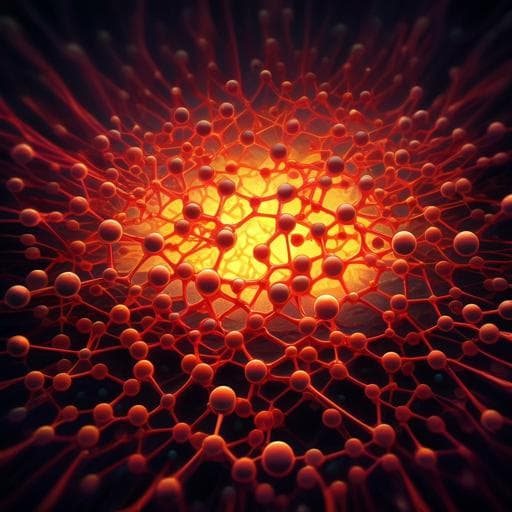
Engineering and Technology
High thermoelectric figure of merit of porous Si nanowires from 300 to 700 K
L. Yang, D. Huh, et al.
This groundbreaking research reveals the synthesis of large-area, wafer-scale arrays of porous silicon nanowires with an unprecedented ultra-thin Si crystallite size, demonstrating a ZT of 0.71 at 700 K—remarkably higher than previously observed for Si-based thermoelectrics at that temperature. The authors explored the potential to achieve even greater performance at higher temperatures.
~3 min • Beginner • English
Introduction
Roughly half of global primary energy is rejected as waste heat across a wide temperature range, with temperatures above ~573 K offering the highest Carnot potential for conversion to electricity. Techno-economic analyses indicate that thermoelectric (TE) systems operating above ~550–573 K can cost-effectively convert waste heat and compete with other zero-carbon technologies, while also reducing heat exchanger costs at higher hot-side temperatures. Silicon (Si), despite its low bulk thermoelectric figure of merit (ZT ≈ 0.01 at 300 K) due to high thermal conductivity (κ ≈ 145 W/m·K), became promising after 2008 reports showed rough or thin Si nanowires (SiNWs) could reduce κ to ~1 W/m·K and yield ZT ~0.2–0.6 at 300 K. However, prior high-ZT single SiNW measurements were largely limited to T ≤ 300 K. Challenges at elevated temperatures include radiation heat losses and membrane coupling in microdevices, instability of Pt heater/thermometers, and difficulty in concurrently measuring κ, σ, and S on the same sample. Earlier studies often measured S and σ on different samples and did not systematically explore effects of porosity and doping. The purpose of this study is to develop wafer-scale porous SiNWs with ultra-small crystallite sizes, implement a high-accuracy high-temperature measurement platform enabling simultaneous κ, σ, and S measurements on single nanowires, and systematically optimize porosity and doping to maximize ZT from 300 to 700 K.
Literature Review
Key prior works established that nanostructuring Si dramatically lowers κ and can enhance ZT: rough SiNWs and thin SiNW arrays achieved κ ~1 W/m·K and ZT up to ~0.6 at 300 K (Hochbaum et al., Boukai et al.). Other Si-based forms (holey Si, polycrystalline nanotube meshes, and nanobulk Si) showed improvements at various temperatures, with Bux et al. reporting ZT ≈ 0.70 at 1100 K for nanobulk Si. However, most single-nanowire measurements at high T faced significant metrology challenges, often measured S and σ on different wires, and typically lacked precise doping characterization. Theoretical descriptions of rough SiNW transport have also been difficult to reconcile with experiments. These gaps motivate concurrent multi-property measurements on single porous SiNWs with controlled porosity and well-quantified doping, and modeling that accounts for nanopore boundary scattering.
Methodology
Fabrication of porous SiNWs: Large-area, wafer-scale porous SiNW arrays were fabricated by combining nanoimprint lithography (NIL) to pattern metals and top-down metal-assisted chemical etching (MACE). Post-doping was performed using spin-on dopant (SOD) boron in spin-on-glass, followed by high-temperature annealing (typically 850 °C for 30 min in Ar/O2 for heavy doping; 700 °C for 15 min for lighter doping), and HF removal of the dopant glass. Porosity (ϕ) was tuned by initial wafer doping, H2O2 concentration during MACE, and post-doping conditions, achieving ϕ ≈ 9–61%. The porous SiNWs remained single crystalline (SAD), with average Si crystallite sizes of ~3.8–4.7 nm determined from photoluminescence peak positions via quantum confinement analysis. Porosity was measured via N2 gas adsorption (BJH) for highly porous samples and a gravimetric method for low to moderate porosity samples.
Doping characterization: Boron concentration p was quantified by secondary ion mass spectrometry (SIMS) using a Cameca NanoSIMS 50L on drop-cast nanowires, calculating cB from boron-to-silicon ion count ratios with relative sensitivity factors.
Thermoelectric measurements: Individual SiNWs were transferred from arrays by sonication into reagent alcohol, drop-cast on PDMS, picked up with a microprobe, and placed bridging two suspended SiNx membranes integrating Pt serpentine heaters/thermometers and electrodes. Measurements were conducted in high vacuum (<1 × 10^−6 mbar) within a cryostat. To enable accurate high-T measurements, the platform incorporated: (1) additional radiation shielding to minimize radiative losses; (2) pre-annealing of microdevices at ~1000 K in Ar to stabilize Pt heaters/thermometers; and (3) calibration with an empty device to quantify background radiative thermal conductance. Electrical resistance was measured via a four-probe setup using a DAQ-controlled current source, voltage and current amplifiers, with high-input-impedance instrumentation for high-resistance samples. A Wheatstone bridge with a blank device enhanced sensitivity for κ measurements. The Seebeck coefficient S was recorded simultaneously by measuring the temperature difference between membranes and the induced thermovoltage across inner electrodes.
Data reduction and modeling: Effective thermal and electrical conductivities (κ_eff = G_th L/A, σ_eff = L/(R A)) were extracted based on the nanowire diameter (A = πD^2/4) without porosity correction; properties of the solid Si skeleton were obtained using effective medium theory scaling by (2 − ϕ)/(2 + ϕ). Contact thermal resistance was verified negligible. Theoretical modeling used the Callaway-Holland formalism for lattice κ, Boltzmann transport with relaxation time approximation for σ, and a diffusion model for S, incorporating nanopore boundary scattering via a boundary scattering length ~4V/S, where V and S are the solid volume and surface area of the porous structure. Electronic thermal conductivity κ_e was estimated by the Wiedemann–Franz law and added to lattice κ where relevant.
Key Findings
- Achieved simultaneous measurements of κ, σ, and S on the same porous SiNW up to 700 K using an advanced suspended microdevice with radiation shields and high-temperature annealing.
- Synthesized wafer-scale porous SiNW arrays with ultra-thin crystallite sizes (~3.8–4.7 nm), porosity 9–61%.
- Best-performing wires: ϕ = 46% with boron doping p ≈ 2.2 × 10^20 cm^−3 and diameters ~152, 171, and 184 nm, yielding consistent results across three samples.
- ZT reached 0.31 at 300 K and 0.71 at 700 K (average across best three samples), more than 18× bulk Si and over 2× higher than any prior nanostructured Si-based thermoelectric at 700 K (reported range 0.14–0.32).
- κ was reduced by about an order of magnitude or more compared to bulk Si due to nanopore boundary scattering; representative room-temperature κ values for porous SiNWs spanned ~2.18–9.32 W/m·K (vs bulk ~145 W/m·K), depending on porosity and doping.
- σ decreased with increasing porosity due to removal of dopants and, beyond the percolation threshold (ϕ ≳ 57%), hopping-dominated transport causing ultralow σ; post-doping was essential to recover σ at moderate porosity.
- S remained comparable to bulk Si across temperature for optimally doped, moderately porous wires, enabling a power factor similar to bulk while maintaining drastically lower κ, thus elevating ZT.
- Theoretical modeling incorporating nanopore boundary scattering (boundary length 4V/S) matched measured trends for κ and σ across varying ϕ and p; S modeling agreed better at higher temperatures. For the highest-ZT sample, electronic thermal conductivity contributed non-negligibly to total κ at high T.
- Extrapolation based on observed temperature independence of κ, σ, and S for the best samples suggests Z nearly constant with T, implying ZT ≈ 1 at 1000 K.
Discussion
The study demonstrates that engineering porosity and doping in SiNWs can decouple thermal and electronic transport sufficiently to achieve high ZT at elevated temperatures. By driving κ down substantially via nanopore boundary scattering while preserving a power factor comparable to bulk Si through optimal heavy boron doping at moderate porosity (~46%), the resulting ZT improves dramatically from room temperature to 700 K. Concurrent measurements of κ, σ, and S on identical nanowires remove sample-to-sample variability and confirm that, for the best-performing wires, transport coefficients are relatively temperature independent over 300–700 K, yielding Z approximately constant and ZT rising linearly with T. Analytical modeling with a boundary scattering length scaling as 4V/S captures the dependence of κ on porosity and σ on both porosity and carrier concentration, supporting the mechanistic understanding. Compared to prior nanostructured Si forms, the ultra-small crystallite sizes (~4 nm) further suppress κ, explaining the superior high-T ZT relative to rough wires, arrays, and nanobulk Si. These findings indicate that porous SiNWs are viable candidates for cost-effective high-temperature waste-heat recovery.
Conclusion
This work reports wafer-scale porous Si nanowires with ultra-small crystallites and concurrently measured thermoelectric properties on single wires, achieving ZT = 0.31 at 300 K and 0.71 at 700 K—exceeding prior Si-based nanostructured thermoelectrics at similar temperatures. The combination of significant κ suppression via nanopore boundary scattering and maintenance of bulk-like power factor enables the high ZT. Analytical models incorporating boundary scattering reproduce measured κ, σ, and S trends and suggest Z is nearly temperature independent, implying ZT ≈ 1 at 1000 K. Future research should: (i) develop high-temperature-stable heater/thermometer materials to validate performance beyond 700 K, (ii) optimize porosity-doping-geometry to balance σ and κ without entering hopping-dominated regimes, and (iii) integrate large-area porous SiNW arrays into practical thermoelectric modules addressing contacts, scalability, and reliability.
Limitations
- Measurement platform limitations: Pt/Cr heaters/thermometers become unstable near and above ~1000 K, constraining experimental validation to ≤700 K despite model predictions to 1000 K.
- Modeling assumptions: Analytical treatment of random nanoporous structures relies on an effective boundary scattering length (4V/S) and effective medium scaling; real microstructures may deviate, and modeling S showed discrepancies at lower temperatures.
- Transport trade-offs: Very high porosity (≥ percolation threshold ~57%) induces hopping-dominated conduction and severely reduces σ, limiting achievable power factor.
- Porosity characterization: For low-to-moderate porosity, gravimetric methods were required as some pores are inaccessible to N2 adsorption; this may introduce uncertainty compared to direct pore accessibility measurements.
Related Publications
Explore these studies to deepen your understanding of the subject.







